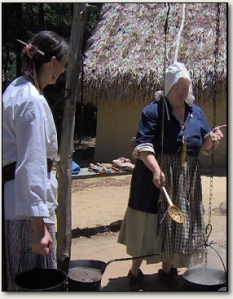Central and Eastern European meals centered around sauerkraut, cabbage, potatoes, dried fruit, and bits of pork, usually sausages or bits and pieces, and the families who immigrated to Lancaster and surrounding counties in PA in the 1730’s brought those foods with them where they remain popular today.
“The Jewish people have their kosher chicken; the Bohemians roast pork, sauerkraut, and dumplings; Syrians their sweets—and Americans a thick beefsteak with occasional side dishes from all the others”. – Harper’s Weekly. Dec. 1918.
In June 1906, a woman living in the Bavarian village of Spitzendorf was reported as having lived to the age of 118 on a diet of, “sauerkraut, dumplings, potatoes, and buttermilk”. Whether her longevity was the product of diet, lifestyle, or genetics is anybody’s guess, but the diet certainly doesn’t seem to have had any adverse reaction. – The Pharmaceutical Era.
“To the Pennsylvania Dutchman such a dinner always means sauerkraut, boiled with a good-sized piece of fresh pork, preferably, and served with mashed potatoes and ‘knep’ [dumplings]…The kraut and meat are boiled together until the meat is tender, then it is removed from the kettle and the dumplings popped in and boiled briskly with the kraut. Browned butter is poured over the ‘knep’ when they are placed on the hot platter, and I can fancy no more tempting table than the one with plates of meat and deliciously light dumplings at top and bottom, while tureens of kraut and mashed potatoes flank the sides…How we used to beg for milk potato soup, or, better still we thought, for brown flour potato soup. The former is merely milk boiled to which have been added potatoes sliced thin and boiled soft, and rivels, with seasoning to taste, but the latter is entirely unique in the history of soups. The recipe is this:
Pare and slice thin some white potatoes then put them on to boil in a kettle with plenty of water. While these are cooking tender, brown in a pan six teaspoonfuls of flour with butter enough to make a rich, golden brown. Thin this with the water before stirring into the potatoes, to prevent the soup from becoming lumpy. Then add finely cut parsley, pepper, salt and the inevitable ‘rivels’. If the soup is too thick, thin it with water, boil hard for five minutes and serve…
Another recollection of those…days is that of a big dining-room, heated by an iron stove, where, over backs of chairs and on the long extension table were spread sheets of yellow nudel dough. How often were my sister and I set to work rolling the sheets into long thin tubes, and then cutting them as fine as possible into the finished nudeln. Supper on such a day had usually for its ‘piece de resistance’ a huge dish of boiled ‘noodles’ dressed with brown butter and breadcrumbs, also browned to a turn with the butter. This dish rejoiced in the name of ‘Schmelzte nfidel’, if that be the way it was spelled. ” – The Christian Advocate. April 11, 1907.
The writer of that article described the making of filled dumplings which she thought fit for the immortals.
“Into a big frying pan are put plenty of butter and a finely minced onion. Before either can brown, mashed potatoes and bread cut fine are added, with parsley, pepper and salt, and sometimes sweet marjoram, an herb that takes the place of the New Englander’s sage in their cookery. Stir this mixture constantly till heated through and through. Then break over it eggs enough to make a slightly moist paste, and heat over a slow fire. While this is heating, the cook makes a dough only a little less stiff than that for noodles. Roll out some of this dough into the shape of a small saucer. Place on it some filling and fold it together into a half moon, pinching the edges tight shut as for pie. Lay on a floured platter until the ‘knep’ are ready. Meanwhile a large kettle has been filled with water, well salted, and allowed to come to a boil. Into this the ‘knep’ are plunged, not too many to crowd the space, the cover is put on tight and they are allowed to boil for fifteen minutes, approximately.
During the boiling period the cook is busy making the dressing. Breadcrumbs have been browned in butter. These are to be sprinkled over the half-moon dumplings. To about a pint of boiling water has been added some of the ‘filling’. Seasoning has been tested, and a raw egg has been stirred into the gravy. This is poured over the dumplings.”
Like Southern fried potatoes and cornbread, many dishes like sauerkraut, were relished at home, but were felt too coarse for visitors. “…it was somewhat out of season for sauerkraut but our southern friends seemed to think that as they were among the ‘Pennsylvania Dutch,’ that favorite dish would be found the whole of the year. They did not know that like their ‘hog and hominy’, sauerkraut was especially a home dish, and never set before strangers”. – Hoke, Jacob. The Great Invasion of 1863. 1887. Dayton, OH.
Hopefully my foray into Pennsylvania Dutch cuisine has shown that the Pennsylvania Dutch people are much more than the Amish of the Lancaster, PA area, and that the cuisine is much more than Shoofly pie. Watch for the upcoming post as I prepare the ubiquitous pork with sauerkraut and dumplings and serve up some Blissful Meals from my own Alabama kitchen.












You must be logged in to post a comment.